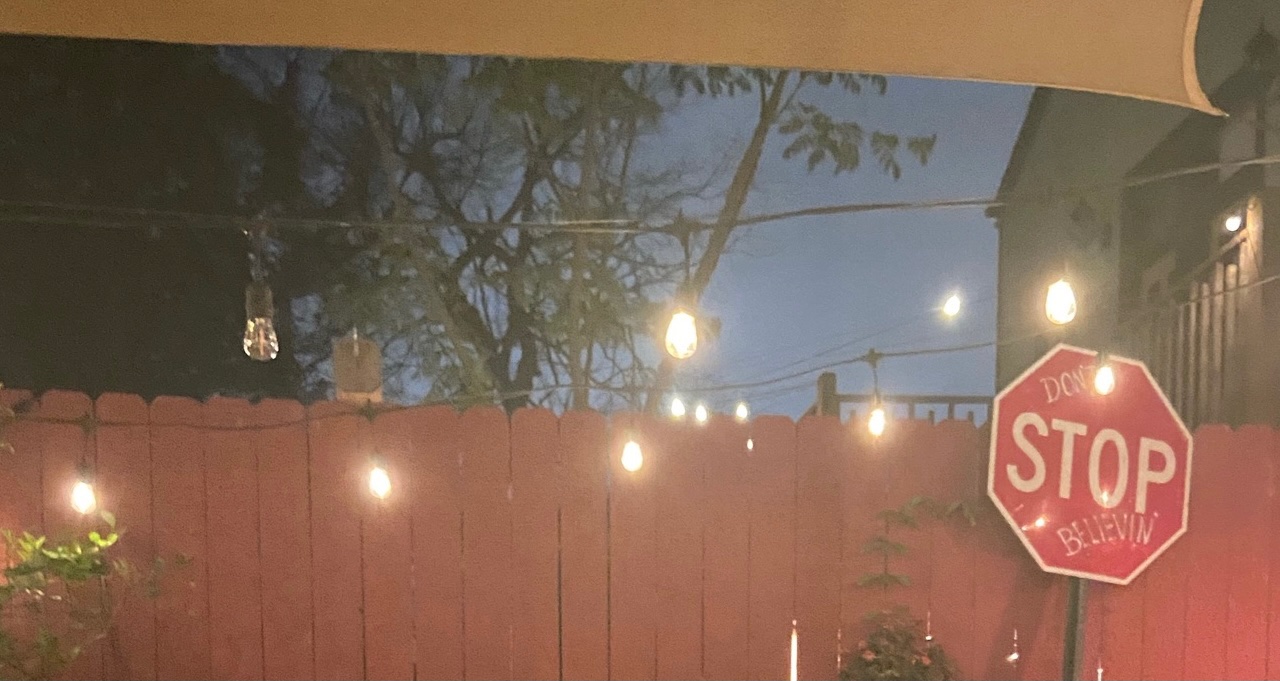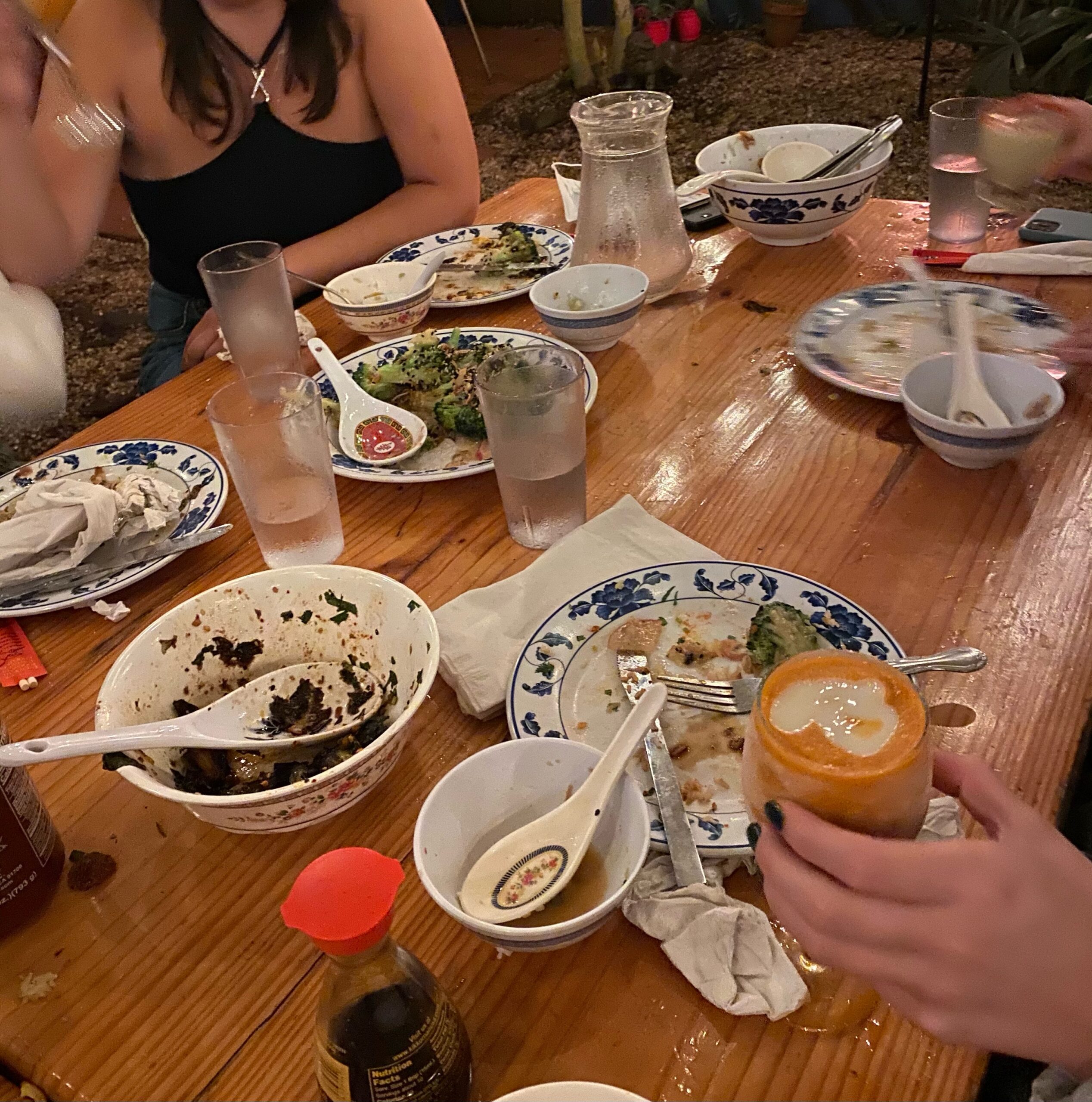Located on The Bywater’s central commercial street, St. Claude Avenue, and among the city’s most popular restaurants – such as Bacchanal Wine & Spirits, Bywater American Bistro, and Pizza Delicious –lies Red’s Chinese. Resting between Montegut and Clouet Street, the restaurant is advertised to passersby with nothing but an illuminated red square jutting out from the building it inhabits. The restaurant is overshadowed by the irrelevant signage on the building’s seemingly abandoned top floor, which reads “GROCERIES,” “ICE,” “TAQUERIAS,” and “MEATS.” Those not specifically seeking out the family-style New Orleans-esque Chinese food experience may never find out that inside what might appear to be a closed-down laundromat or hole-in-the-wall liquor store exists a utopia filled with brightly colored Thai tea daiquiris, heaping platters of Cajun-inspired fried rice, and giant bowls of ginger scallion noodles.
After being bombarded by the fluorescent lighting that gleams from the restaurant’s white awning, diners enter the narrow interior of Red’s. Sounds of the clinking of utensils combined with the humming of the daiquiri-dispensers’ motor fill the room. With low ceilings and dim lighting, the restaurant’s ambiance reflects that of an intimate dive bar. In a study aimed in part at examining “how [subjects] assess the degree of intimacy,” researchers Suzanne J. Carr and James M. Dabbs found a strong correlation between lighting, physical closeness, and intimacy. They write, “[Subjects] considered the [conversation] to be more intimate and less appropriate both when the lighting was dim and when the interview was seated near to them.” The restaurant’s dim lighting and the small physical space it occupies work together to promote a sense of emotional closeness among diners.
Behind the building lies its adjacent rectangular patio, enclosed by the back of the restaurant and a tall wooden fence – two walls of which are painted a deep red, while the one opposite the building boasts a colorful mural that depicts lush branches of blooming cherry blossoms surrounding a maneki-neko. Lining these fences are small, deliberately placed trees and a string of lightbulbs that begin to illuminate the space as the sun sets. A red stop sign – with “DON’T” and “BELIEVING” messily scribbled in white writing above and below the sign’s text, respectively – rests against one of the red walls. In Western culture, the color red generally denotes intimacy. A study concerning color associations, conducted by Chin Last, surveyed American college students who used words like “love,” “Valentine’s Day,” and “heart[s],” in association with color. Enclosed within red walls, diners at Red’s are immersed in an environment that promotes closeness.

The patio at Red’s Chinese.
As diners sit down at their respective tables and examine the menu, the selection consists of almost exclusively family-style dishes. When all members of a group of diners dig into the same overflowing bowls, a deep sense of connection and shared experience is elicited. In fact, in a 2017 interview with NPR, Ayelet Fishbach, a professor of Behavioral Science at The University of Chicago, stated, “Food is about bringing something into the body. And to eat the same food suggests that we are both willing to bring the same thing into our bodies. People just feel closer to people who are eating the same food as they do. And then trust, cooperation, these are just consequences of feeling close to someone.” Although it’s not uncommon to find pairs of young artists or musicians clinking glasses filled with lime-infused vodka mixed with pineapple sake at tables for two, or couples chatting over smoked tofu buns at what appears (from the vantage point of nosy onlookers like myself) to be a second or third date, the hefty portions make the restaurant the perfect place to foster social connection among large groups of diners.
Among these diners seeking social connection are groups of college students. The newly-minted legal drinkers proudly hand their server drivers licenses that signify their entry into the previously-forbidden adult world of alcohol consumption. They often dine at the restaurant’s largest table – the focal point of the back patio, covered by a draping tarp that protects the eager diners from regular inevitable New Orleans evening drizzles. The proof of the magic of Red’s lies in these students’ audible expressions of joy. Their fists hit the table; they emit sporadic eruptions of contagious laughter between bites of kimchi and smashed cucumbers. Social bonds like these are as much of a basic human necessity as is food, and when we are lucky enough to experience the two hand-in-hand, we fulfill two of our most primal needs. Matthew D. Lieberman, in Why our Brains are Wired to Connect, writes, “Long before there were any primates with a neocortex, mammals split off from other vertebrates and evolved the capacity to feel social pains and pleasures, forever linking our well-being to our social connectedness.” The satiation one gets from dining with close friends cannot be overstated.
John T. Cacioppo and William Patrick, authors of Loneliness: Human Nature and the Need for Social Connection, write, “We are social mammals, and, all other things being equal, congregating among our fellows feels good, and that good feeling undoubtedly amplifies the benefits of other positive experiences.” There’s no doubt that the company of my roommates heightens the tanginess of the ginger garlic sauce slathered over the General’s Chicken. The laughter induced by the repetition of old memories and the rapid development of new inside jokes somehow makes the signature Thai tea daiquiris a more striking shade of orange, and simultaneously mutes the bitterness of the rum, for better or for worse.

The end of a meal at Red’s Chinese.
At the end of a meal at Red’s, you’ll look down at a wooden table and find giant, floral-patterned serving plates scraped clean; empty white bowls once inhabited by delicious broth and noodles; glasses of half-melted ice that once contained strong, flavorful drinks; and stray grains of rice and pieces of chicken that, sadly, lost their way en route to your mouth. The hideout leaves not just my heart and stomach satisfied, but on the brink of explosion.
 NOLAbeings
Multimedia artist Claire Bangser created NOLAbeings as a portrait-based story project that marries...
NOLAbeings
Multimedia artist Claire Bangser created NOLAbeings as a portrait-based story project that marries...
 Data corner: Adobe Suite (create a PDF, social media graphic, presentation, edit a photo and video
Data corner is where you go to work with analytics and top tech skills. It takes on everything from PERL and SQL to Canva and Sprout Social.
Data corner: Adobe Suite (create a PDF, social media graphic, presentation, edit a photo and video
Data corner is where you go to work with analytics and top tech skills. It takes on everything from PERL and SQL to Canva and Sprout Social.
